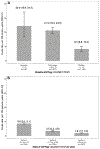Association of Intra-individual Differences in Estimated GFR by Creatinine Versus Cystatin C With Incident Heart Failure
- PMID: 35817274
- PMCID: PMC9691565
- DOI: 10.1053/j.ajkd.2022.05.011
Association of Intra-individual Differences in Estimated GFR by Creatinine Versus Cystatin C With Incident Heart Failure
Abstract
Rationale & objective: Lower estimated glomerular filtration rate (eGFR) is associated with heart failure (HF) risk. However, eGFR based on cystatin C (eGFRcys) and creatinine (eGFRcr) may differ substantially within an individual. The clinical implications of these differences for risk of HF among persons with chronic kidney disease (CKD) are unknown.
Study design: Prospective cohort study.
Setting & participants: 4,512 adults with CKD and without prevalent HF who enrolled in the Chronic Renal Insufficiency Cohort (CRIC) Study.
Exposure: Difference in GFR estimates (eGFRdiff; ie, eGFRcys minus eGFRcr).
Outcome: Incident HF hospitalization.
Analytical approach: Fine-Gray proportional subhazards regression was used to investigate the associations of baseline, time-updated, and slope of eGFRdiff with incident HF.
Results: Of 4,512 participants, one-third had eGFRcys and eGFRcr values that differed by over 15 mL/min/1.73 m2. In multivariable-adjusted models, each 15 mL/min/1.73 m2 lower baseline eGFRdiff was associated with higher risk of incident HF hospitalization (hazard ratio [HR], 1.20 [95% CI, 1.07-1.34]). In time-updated analyses, those with eGFRdiff less than -15 mL/min/1.73 m2 had higher risk of incident HF hospitalization (HR, 1.99 [95% CI, 1.39-2.86]), and those with eGFRdiff ≥15 mL/min/1.73 m2 had lower risk of incident HF hospitalization (HR, 0.67 [95% CI, 0.49-0.91]) compared with participants with similar eGFRcys and eGFRcr. Participants with faster declines in eGFRcys relative to eGFRcr had higher risk of incident HF (HR, 1.49 [95% CI, 1.19-1.85]) compared with those in whom eGFRcys and eGFRcr declined in parallel.
Limitations: Entry into the CRIC Study was determined by eGFRcr, which constrained the range of baseline eGFRcr-but not eGFRcys-values.
Conclusions: Among persons with CKD who have large differences between eGFRcys and eGFRcr, risk for incident HF is more strongly associated with eGFRcys. Diverging slopes between eGFRcys and eGFRcr over time are also independently associated with risk of incident HF.
Keywords: Biomarker; HF hospitalization; cardiovascular risk stratification; chronic kidney disease (CKD); creatinine; cystatin C; eGFR slope; estimated glomerular filtration rate (eGFR); filtration marker; heart failure (HF); kidney function; measurement accuracy.
Published by Elsevier Inc.
Figures


References
Publication types
MeSH terms
Substances
Grants and funding
LinkOut - more resources
Full Text Sources
Medical
Research Materials
Miscellaneous

